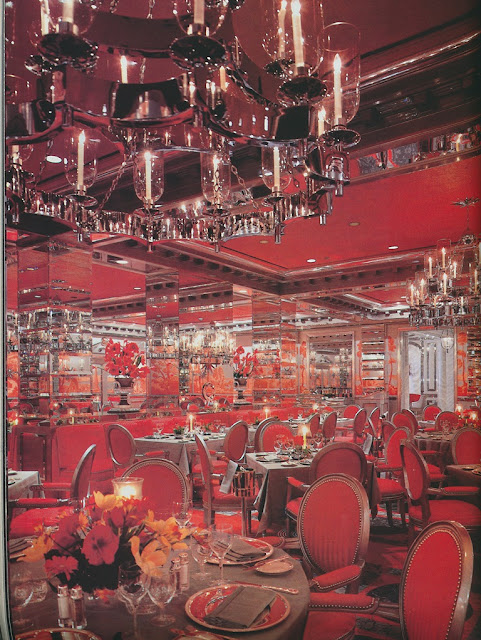Monday, July 18, 2016
Valerian Rybar's Feverish Eclecticism
Recently, two neighbors of mine, both fellow children of the Eighties, joined me in watching my all-time favorite mini-series, Lace, which I sheepishly admit to owning on DVD. I adore Lace, because everything about it captured the flash and the cash of the 1980s, though in slightly dramatic fashion. Most of the characters were chauffeured around in Rolls-Royces, donned high-fashion wardrobes (think Ungaro by day, Vicky Tiel by night), and plotted revenge and love affairs while frequenting only the most glamorous locales, including Ascot and various French chateaux. Life wasn't bad for the lead characters, except for that secret that almost led to their undoing.
With Eighties decadence on the brain, it seems fitting to talk about The Carlyle, a Houston, Texas restaurant that, no doubt, would have been just the sort of establishment that the ladies of Lace would have been drawn to. Decorated by that virtuoso of haute luxury, designer Valerian Rybar, The Carlyle was a veritable den of design iniquity, all mirror, velvet, wanton red, and risque black. Named after the Upper East Side hotel, The Carlyle was opened in 1983 by Houston businessman, Harold Farb, who gave carte blanche to Rybar. And it's a good thing he did, too, because otherwise, we might not have had the opportunity to behold such a lavishly appointed restaurant.
There was a mirror-clad Entrance Foyer that led to the Reception Room, which was outfitted in an Eighties-inflected version of the Neoclassical style. "Although I call it Neo-Classical, the result incorporates elements deriving from ancient Rome, the Baroque, the Directoire period," opined Rybar. "The cool discipline of a Neo-Classical frameworks allows you to get away with some feverish eclecticism!"
Dinner and dancing took place in red-drenched rooms, which, like the other spaces, was embellished with Rybar's profuse use of mirror. And finally, there was the Venetian Room, a private dining room that was swathed in chic black. Said Rybar, "This all-black decor makes guests appear extraordinarily glamorous."
"A public space of the scale and ambition of this one will surely attract all manners of adventurers," predicted Rybar. But based on what I've read online, those adventurers never really came, forcing Farb to later close the supper club. A shame, really, because for all of the interiors' flashiness, the restaurant had a flair that, today, seems rather novel and even exciting. After a decade of dining among rough-hewn wood, industrial light fixtures, and Edison bulb-lighting, I, for one, would be thrilled to spend a Saturday night ensconced in crimson and mirror.
The Entrance Foyer that was kitted out with strip after strip of beveled mirror.
The Reception Room with Rybar's flamboyant interpretation of the Neoclassical style. Beveled mirror serves as architectural embellishments on the walls, while the painted domed ceiling provides a cloudy vista. The silver-metallic-lacquered piano was the finishing touch.
The Main Dining Room was fiery red and silver intensified by a lavish use of mirror. The red and silver scenic wall murals were painted by Robert Walker.
Also crimson was the Red Room, yet another dining room that was also used for dancing. The walls were upholstered in red satin, while the carpet, a Patterson, Flynn & Martin design, had the appearance of inlaid marble. The stainless-steel panels on the wall bore paintings of nymphs and Muses.
The Venetian Room, which was a private dining room. The chandeliers, mirrors, and girandoles were made in Venice of blown black glass. The walls were covered in a black moire fabric from Kravet.
The Men's Lounge was clad in marble and mirror.
All images from Architectural Digest, September 1983, Jaime Ardiles-Arce photographer
Subscribe to:
Post Comments (Atom)
















So much prefer this to the faux'industrial' look that I'm SO over!
ReplyDeleteStefan, You and me both! It was such an over-hyped look to begin with.
DeleteAbsolutely!
DeleteI am having flashbacks, and not in a good way! "Fevered" eclecticism is absolutely right. I too hate the contrived and overused converted warehouse/industrial workshop aesthetic, but please, this is going waaaay back to the opposite end of the pendulum's swing. I wonder when we will ever, if ever, settle on elegance as a byword again.
ReplyDeleteDon't want the '"faux industrial" or this! WAY to OTT! Give me the Ritz in London or Paris for elegant dining.
ReplyDeleteWhat a fabulous post. And what a shame it is gone. I must say that the site does not fit the interior? I guess one has to access/approach it by car. Forget walking in from a sidewalk in a closely built city environment (NYC!) :) thanks for this. It was iconic..Alix in Haverford
ReplyDeleteMy eyes are still recovering. Amazing. I like that "faux industrial" is definitely out. Have a great week. xo Mary
ReplyDeleteDarlings, the 80's are soo going to be back in fashion if The Donald wins in November. This is right up there with the gaudy splendour of his Trump Tower penthouse, which I still find hard to believe is Angelo Donghia's work.
ReplyDeleteI bet Angelo thought to himself, let the great Orangina meddle with the design (you know he did...) and I will just bill, bill, and bill some more, with over-billing built in to cover the inevitable lapses in payment that everyone in NYC has know about from the very beginning.
DeleteHe could have dragged me up into that penthouse for a couple of hours without paying a thing darling. Hw was quite the dish back in the 80s.
DeletePudding may seem quite the dish when first presented, but one almost always suffers "buyer's remorse" after the fact...
DeleteI wonder what happened to the fixtures, furniture and such. I know that Rybar's own mirrored salon in Paris was acquired by the storied boiserie dealers Feau & Cie.
ReplyDeleteOh, this is how I want to remember the 1980s. Places like this made going out an event.
ReplyDelete